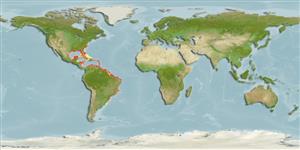分类 / Names
俗名 | 同种异名 | Catalog of Fishes(属, 种) | ITIS | CoL | WoRMS | Cloffa
Elasmobranchii
板鳃亚纲 (鲨鱼与 鱼) (sharks and rays) >
Torpediniformes (Electric rays) >
Narcinidae (Numbfishes)
Etymology: Narcine: Greek, narke = numbness (Ref. 45335).
Environment: milieu / climate zone / depth range / distribution range
生态学
海洋 礁区鱼类; 深度上下限 1 - 43 m (Ref. 13608). 亞熱帶的; 37°N - 39°S, 98°W - 34°W
Western Atlantic: Espirito Santo, Brazil to northern Argentina (Carvalho, pers. comm.). North Carolina, USA to Florida, northern Gulf of Mexico, central Lesser Antilles and Yucatan (Ref. 26938).
西大西洋: 巴西的聖埃斯皮里托到阿根廷北部 (Carvalho , pers. comm.)。 美國北卡羅萊那州到佛羅里達,墨西哥灣北部, 中央的小安地列斯群島與尤卡坦半島.(參考文獻 26938)
Length at first maturity / 大小 / 重量 / 年龄
Maturity: Lm 28.8 range ? - ? cm
Max length : 54.0 cm WD 雄鱼/尚未辨别雌雄; (Ref. 26340); common length : 35.0 cm WD 雄鱼/尚未辨别雌雄; (Ref. 5217); 最大体重: 650.00 g (Ref. 6902)
简单描述
检索表 | 型态特徵 | 形态测量图
A pale sand-colored ray, often with ellipses of dark spots on dorsal side of rounded disk (Ref. 26938). Grayish to reddish brown, many rounded blotches outlined with blackish spots. Dark bands across tail up to dorsal fin. Snout darkened (Ref. 7251).
一个白沙色的 , 时常以椭圆形的深色斑点在圆形圆盘的背面两侧上.(参考文献 26938) 浅灰色的到红褐色的, 许多圆形的斑块边缘有黑色的斑点了。 横过尾部向上到背鳍的深色条纹。 吻颜色较深。 (参考文献 7251)
Inhabits coastal waters, on sand or mud bottoms (Ref. 26340). Common along sandy shorelines, sometimes near coral reefs (Ref. 12951). Aggregates in shallow waters ca. 10-20 m deep during summer and autumn months, dispersing to deeper waters during winter (Ref. 114953). Buries itself with only eyes protruding (Ref. 12951). Nocturnal, moves to shallow bays at night to feed; prefers worms, but may take juvenile snake eels, anemones, and, small crustaceans (Ref. 12951). Produces broods of 4 to 15 young (Ref. 26938). Reaches ca. 45 cm TL. Both sexes mature by 27 cm TL; birth size at ca. 11 cm TL (Ref. 114953). Can discharge between 14 and 37 volts. Contact with the skin can produce a severe electric shock. In addition to the main electric organ, this species possesses a bilateral accessory electric organ (Ref. 10011) speculated to have a possible role in social communication (Ref. 10489). Reported to taste good, but not fished commercially. Traded as an aquarium fish at Ceará, Brazil (Ref. 49392).
在沙或泥底部上, 栖息于沿岸水域。 (参考文献 26340) 普遍的沿着沙质海岸线, 有时在珊瑚礁的附近.(参考文献 12951) 埋藏它本身,仅仅眼伸出。 (参考文献 12951) 夜行的, 移动到浅湾在晚上觅食; 偏爱蠕虫, 但是可能吃蛇鳗幼鱼, 卷曲异辐海葵, 与, 小型甲壳动物.(参考文献 12951) 一窝生产 4 到 15个幼鱼。 (参考文献 26938) 能放电电压介于 14 与 37 伏特之间。 触碰皮肤能生产一个严重的电击。 以及主要的发电器,这种持有被深思有一个社会的沟通的可能的角色的一个左右对称的附属发电器官 (参考文献 10011) 。 (参考文献 10489) 报告尝起来好, 但是不商业性地渔捕。 在巴西的塞阿腊作为一个水族馆鱼交易了。 (参考文献 49392)
Life cycle and mating behavior
Maturities | 繁殖 | Spawnings | Egg(s) | Fecundities | 仔鱼
Ovoviviparous. Sex ratio of embryos is about one to one, however, small mothers may have predominantly female embryos and that for a given mother, embryos tend to be of one sex (Ref. 46979). Maximum number of embryos per female may reach 15. The young are capable of giving off electric charges even before they are released from the womb (Ref. 46978).西大西洋: 巴西的聖埃斯皮里托到阿根廷北部 (Carvalho , pers. comm.)。 美國北卡羅萊那州到佛羅里達,墨西哥灣北部, 中央的小安地列斯群島與尤卡坦半島.(參考文獻 26938)
Robins, C.R. and G.C. Ray, 1986. A field guide to Atlantic coast fishes of North America. Houghton Mifflin Company, Boston, U.S.A. 354 p. (Ref. 7251)
人类利用
渔业: 自给性渔业; 水族馆: 商业性
工具
特别资料
下载 XML
网络资源
Estimates based on models
Preferred temperature (Ref.
123201): 22.9 - 28, mean 25.6 °C (based on 442 cells).
Phylogenetic diversity index (Ref.
82804): PD
50 = 0.5000 [Uniqueness, from 0.5 = low to 2.0 = high].
Bayesian length-weight: a=0.01122 (0.00605 - 0.02082), b=2.90 (2.73 - 3.07), in cm total length, based on LWR estimates for this species & (Sub)family-body (Ref.
93245).
营养阶层 (Ref.
69278): 3.2 ±0.4 se; based on diet studies.
回复力 (Ref.
120179): 低的, 最小族群倍增时间4.5 - 14 年 (Assuming fecundity<100).
Fishing Vulnerability (Ref.
59153): Low to moderate vulnerability (34 of 100).
Nutrients (Ref.
124155): Calcium = 6.47 [0.67, 106.25] mg/100g; Iron = 0.472 [0.039, 5.319] mg/100g; Protein = 16.6 [12.4, 21.0] %; Omega3 = 0.145 [0.049, 0.421] g/100g; Selenium = 14.3 [2.3, 70.5] μg/100g; VitaminA = 22.2 [1.8, 283.1] μg/100g; Zinc = 0.82 [0.06, 9.22] mg/100g (wet weight);
